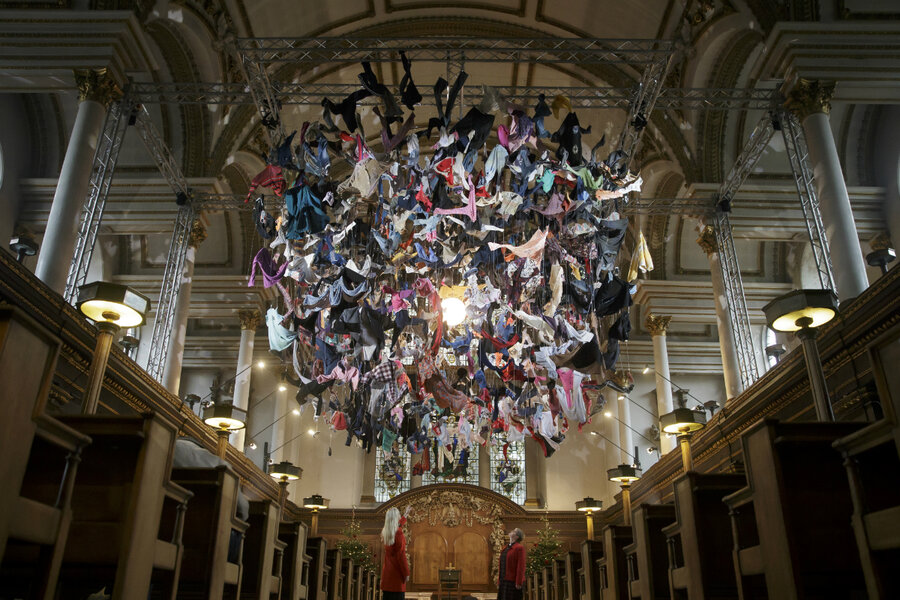A suspended sculpture in London reminds viewers of the plight of refugees
| London
As a group of homeless men doze on pews, and colorful t-shirts and baby shoes hang low from the ceiling, London's St James's Church is ready for Christmas.
The atmospheric church built by Christopher Wren in 1676 in London's smart Piccadilly area is home this festive season to a haunting exhibition by British artist Arabella Dorman.
Ms. Dorman has collected and sculpted more than 700 items of clothing discarded on the beaches and olive groves of Lesbos island in Greece, to highlight the plight of refugees.
A brightly colored African-print dress, billowing burqas and a faded football shirt surround a glowing orb that brightens and dims, representing the oscillating hope and despair of refugees who arrive on the Greek shores.
"I picked up some of these clothes and was immediately struck by the hidden presence of the wearer, and I reflected on the power of clothes to tell a story," Dorman told the Thomson Reuters Foundation.
"Every time you pick up a new item of clothing you're engaging with another life."
From afar, the clothes hang in a mass like a ghostly chandelier adorning the nave of the church. But the artist, who has worked in Gaza, Afghanistan, and Iraq, wants worshippers to look closer and reflect on the individuals who once wore the garments.
"Refugees are not numbers, they are people," she said.
Hurried Christmas shoppers, wrapped up in scarves to keep out the winter cold, stop by the church for a moment of quiet contemplation.
"It's very beautiful and very touching," said Tahlia, an Australian tourist. "It made me think that everyone deserves to have a place to come and feel welcome."
Passer-by Bill Richardson said he felt challenged by the artwork and curious about the tragic journeys the tangled clothes portrayed.
"It did make me stop and think about how grateful I am in life and to give thought and consideration to those not as fortunate as myself," he said.
More than 3,000 people have seen the installation in the last 10 days as they attend the church for carol services and worship, said Rector Lucy Winkett.
Ms. Winkett said the message of Christmas had been forgotten, and the refugee crisis had strong parallels to the Christian nativity story of Mary, Joseph, and Jesus.
"It's a very modern story of a despotic leader, a dangerous situation, and a family fleeing from peril," she told the Thomson Reuters Foundation.
"This is actually what Christmas is about, this story happening in Europe right now, that's the Christmas story."
The installation is entitled "Suspended" as the clothes dangle above the church altar and it also represents the state of uncertainty in which refugees find themselves.
"They are suspended in limbo – stuck between a past to which they cannot return and a future to which they cannot move forward," Dorman said.
The project aims to raise funds for the Starfish Foundation, a charity in Lesbos where hundreds of refugees still come ashore each month.
On Tuesday alone, 267 people arrived by boat, mostly from Syria, said Melinda McRostie, founder of the aid organization that is fundraising for infant buggies for the island that hosts more than 900 refugee children among 8,500 asylum seekers.
The exhibition helps "people understand that this problem is a real problem with real people and it could have been them wearing these clothes," said McRostie.
Thousands of asylum-seekers have become stranded on Lesbos and four other Greek islands close to Turkey since the European Union agreed a deal with Ankara in March 2016 to shut down the route through Greece.
"This situation is not going to go away," said Dorman. "[It] is in fact deepening and worsening."
This story was reported by the Thomson Reuters Foundation.






